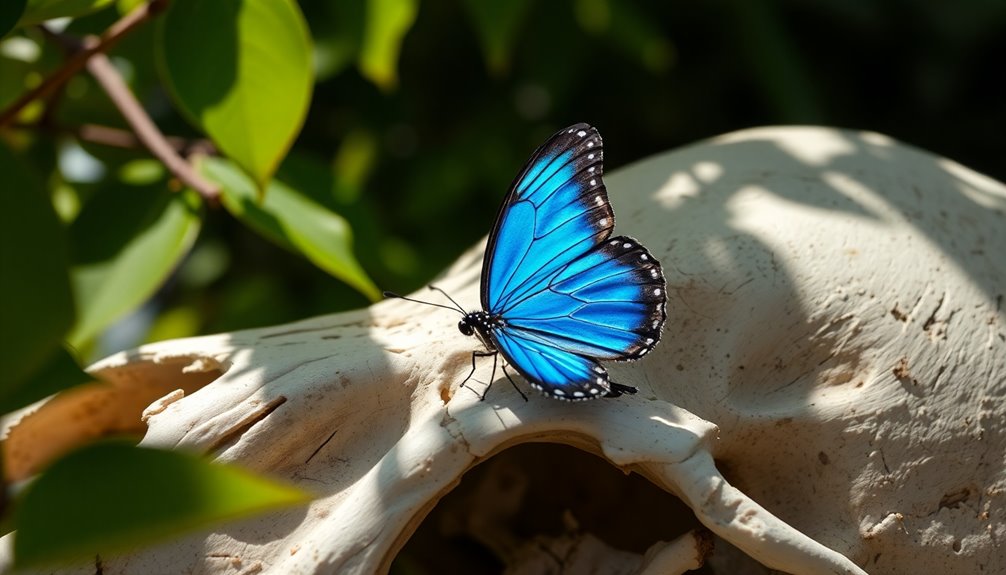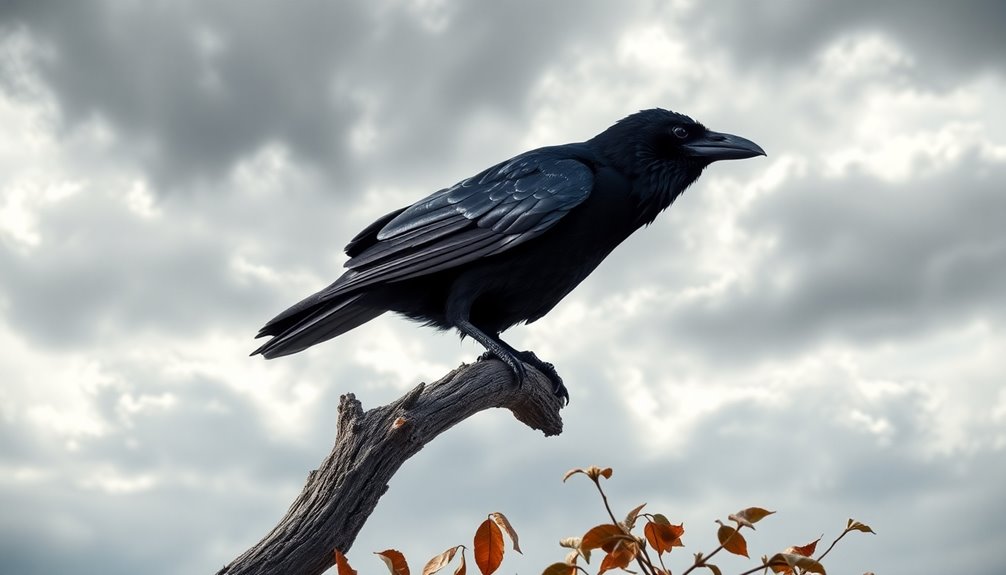The scarab beetle surprises you as a powerful symbol of death and rebirth. In ancient Egypt, it represented the eternal cycle of life, connected to gods like Ra and Khepri. Scarabs were essential in funerary practices, helping the deceased change to the afterlife. Their life cycle, featuring stages of metamorphosis, embodies renewal and resilience. Scarabs also play important ecological roles, assisting in nutrient recycling and improving soil health. This fascinating insect doesn't just symbolize transformation; it reflects deep cultural significance that resonates today. Keep exploring, and you'll uncover even more about the scarab's enduring legacy.
Key Takeaways
- The scarab beetle, particularly *Scarabaeus sacer*, is a prominent symbol of death and rebirth in ancient Egyptian culture.
- Scarabs represent the eternal cycle of life, embodying themes of resurrection and renewal associated with deities like Ra and Khepri.
- Their life cycle, featuring complete metamorphosis, exemplifies transformation and adaptation, reinforcing the idea of continual renewal.
- Scarabs play a vital ecological role by recycling nutrients, promoting soil fertility, and enhancing biodiversity, reflecting natural processes of regeneration.
- Artistic representations of scarabs in ancient artifacts connect them to cosmic order, emphasizing their cultural significance in themes of immortality and protection.
The Scarab Beetle Explained

The scarab beetle, especially the dung beetle *Scarabaeus sacer*, plays an essential role in ancient Egyptian culture as a powerful symbol of death and rebirth. Revered for its unique behavior, the scarab rolls dung balls, which the Egyptians believed mirrored the sun's daily journey across the sky. This act not only represented the cycle of life but also embodied the concepts of regeneration and eternal life.
You'll find that scarab amulets were common in funerary practices, often inscribed with protective spells. Placed in tombs alongside mummies, these amulets were thought to safeguard the deceased on their journey to the afterlife, reinforcing the scarab beetle's association with death and rebirth.
In addition to its cultural significance, the scarab beetle plays an ecological role as a detritivore, recycling nutrients and contributing to environmental balance. This connection between the scarab's actions and the natural world illustrates how the ancient Egyptians viewed the beetle as a powerful symbol of regeneration in both life and death.
Understanding the scarab beetle's importance helps you appreciate its lasting legacy in ancient Egyptian society.
Historical Significance in Ancient Egypt
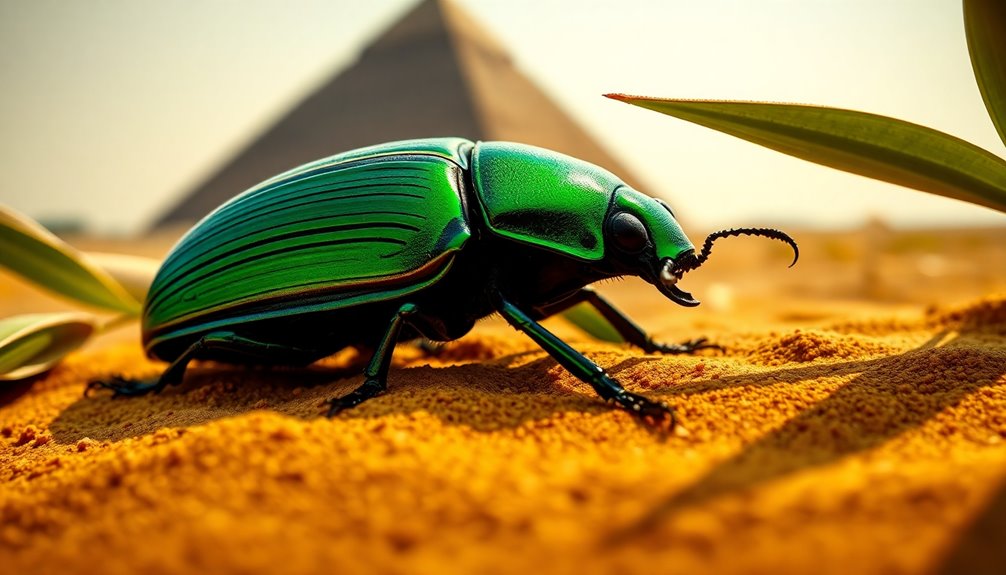
Scarab beetles held immense historical significance in ancient Egypt, symbolizing the eternal cycle of life, death, and rebirth. The dung beetle, *Scarabaeus sacer*, was revered by ancient Egyptians as a sacred emblem, representing regeneration. Scarabs were commonly crafted into amulets and artifacts, believed to offer protection during the afterlife and assist the deceased in their journey.
Ancient Egyptians closely associated the scarab with the sun god Ra and the deity Khepri, both of whom embodied resurrection and the daily rebirth of the sun. This connection reinforced the belief that the scarab could facilitate a smooth passage into the afterlife. In funerary practices, heart scarabs were often placed in tombs, intended to aid the deceased's passage and guarantee a favorable judgment in the afterlife.
Over time, the significance of scarabs evolved. They transformed from simple seals during the 6th Dynasty into intricate jewelry and decorative objects in the New Kingdom, illustrating their enduring cultural importance.
As you explore ancient Egypt, you'll find that the scarab remains a powerful symbol of life, death, and the promise of rebirth, deeply woven into the fabric of Egyptian history.
Symbolism of Death and Rebirth
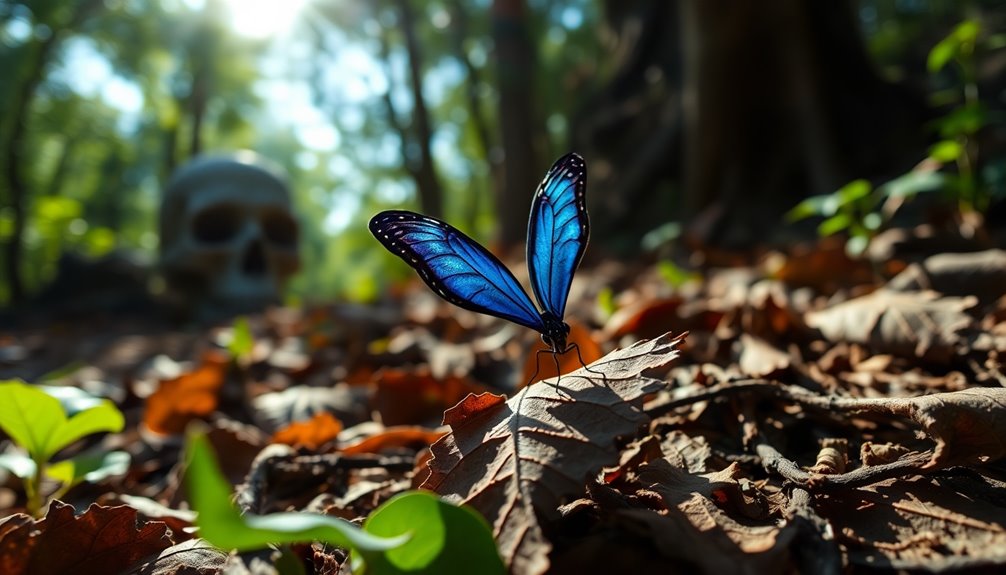
When you think about the symbolism of death and rebirth, ancient Egyptian beliefs immediately come to mind, especially with the scarab beetle.
This tiny creature played a significant role in their understanding of life's cycles, linking the sun's journey to themes of renewal. The scarab beetle's life cycle, which includes complete transformation, mirrors the natural processes of death and rebirth. Historically, the nutritional uses of seeds, such as chia, also reflect the cycle of life, as they provide essential nutrients for growth and vitality. Chia seeds, known for their high fiber content, not only support digestive health but also symbolize the nurturing aspect of life's cycles. Additionally, chia seeds are a complete protein source, containing all nine essential amino acids, which further emphasizes their role in nourishing life.
Today, you might find that modern cultures still interpret these concepts in various ways, reflecting the timeless nature of this symbolism. Additionally, the idea of nutrient retention in raw foods can also symbolize the importance of preserving life and vitality, much like the beliefs surrounding the scarab beetle.
Ancient Egyptian Beliefs
In Ancient Egypt, the scarab beetle served as a powerful symbol of death and rebirth, deeply intertwined with the culture's beliefs about the afterlife. The dung beetle, *Scarabaeus sacer*, was particularly revered for its connection to the sun god Ra and the cyclical nature of life.
You'd find that scarabs embodied regenerative powers vital for the afterlife, with their behavior of rolling dung balls seen as a metaphor for life's eternal cycle. The scarab's association with Khepri, the god representing the rising sun, reinforced its symbolism of transformation and resurrection.
Scarabs weren't just significant in life; they played a pivotal role in funerary practices. Heart scarabs were placed in tombs to aid the deceased's journey to the afterlife, ensuring they'd the protection they needed.
As you explore Ancient Egypt's beliefs, you'll notice the craftsmanship of scarab amulets evolved from simple seals in the Old Kingdom to intricate decorative pieces in the New Kingdom. This evolution reflects their increasing cultural significance, symbolizing a connection between life, death, and rebirth that continues to captivate our imagination today.
Modern Cultural Interpretations
Embracing the symbolism of the scarab beetle, modern culture continues to celebrate its themes of transformation and rebirth. You'll find scarab beetles featured prominently in tattoos and jewelry, representing good luck and protection. Additionally, many vehicle owners are turning to alternative automotive repair as a cost-effective means to maintain their cars, much like the enduring legacy of the scarab. The concept of tiny house living has also gained traction, offering a unique perspective on minimalism and sustainability that echoes the scarab's transformative qualities. Understanding the importance of budgeting strategies can provide individuals with the financial freedom to embrace such lifestyle changes. Furthermore, engaging in cultural intelligence can enhance one's ability to appreciate diverse interpretations of symbols like the scarab across various cultures.
This fascination extends into contemporary art and design, where modern scarabs reflect ancient Egyptian mythology and the life cycle's complexities. In various spiritual practices, the scarab's association with resurrection resonates deeply, making it a powerful emblem of renewal and hope. When you visit Egypt, you might come across scarab replicas and amulets that serve as souvenirs, allowing you to connect with the ancient belief in the beetle's regenerative powers.
Additionally, in literature and film, scarabs often symbolize immortality and the afterlife, reinforcing their role as icons of death and rebirth. Energy-efficient technology has also become a modern symbol of renewal, as it embodies the principles of transformation and sustainability. The importance of regular maintenance in automotive care parallels the scarab's theme of renewal, highlighting how proactive measures can prevent major issues.
By integrating these modern interpretations, you can appreciate how the scarab beetle transcends time, continuing to inspire and evoke a sense of transformation. Whether you're adorning yourself with jewelry or exploring art, the scarab's enduring legacy speaks to the universal themes of life, death, and renewal that resonate through the ages.
Behavioral Traits of Scarabs

When you observe scarabs, you'll notice their fascinating dung-rolling behavior, which plays an essential role in their life cycle.
As you watch, you'll see these beetles engage in impressive courtship rituals and navigate using the Milky Way, showcasing their remarkable skills.
These traits not only highlight their adaptability but also emphasize their connection to themes of nourishment and rebirth.
Dung Rolling Behavior
Scarab beetles are fascinating creatures, renowned for their remarkable dung rolling behavior. These dung beetles exhibit a unique ability to create spherical dung balls, which they roll away to bury for feeding and reproduction. You'll be amazed to learn that they can roll dung balls weighing up to 50 times their own weight, showcasing incredible strength.
Here's a quick look at the three main types of dung beetles:
| Type | Behavior Description | Example Species |
|---|---|---|
| Rollers | Create and move dung balls | Onthophagus taurus |
| Tunnelers | Bury dung in the ground | Geotrupes spinolae |
| Dwellers | Live in dung without moving it | Scarabaeus sacer |
Beyond their physical prowess, scarab beetles navigate using the Milky Way for orientation while rolling their dung balls. This impressive feat highlights their exceptional spatial awareness, making them stand out in the insect world. Their behavior not only helps in nutrient recycling but also plays a significant role in their ecological niche.
Mating Rituals and Courtship
In addition to their impressive dung-rolling skills, scarabs exhibit fascinating mating rituals that reflect their complex social behaviors.
These rituals are particularly prominent among Egyptian scarabs, showcasing their unique courtship techniques. Here's what you can expect:
- Elaborate displays: Males use their prominent horns and body posturing to compete for females, establishing dominance.
- Dung ball performances: Some species roll dung balls in front of females, demonstrating strength and suitability as mates.
- Chemical signaling: Males release pheromones to attract females, showcasing their genetic fitness.
- Tactile interactions: Courtship involves agility and coordination, with males maneuvering around the female to impress her.
- Bonding behaviors: Successful courtship can lead to multi-day mating periods, where pairs engage in mutual grooming.
These mating rituals not only highlight the physical prowess of the scarabs but also their intricate social dynamics.
Watching these behaviors unfold can give you a deeper understanding of their role in nature, especially as symbols of death and rebirth in Egyptian culture.
Navigation and Orientation Skills
Under the vast night sky, scarabs expertly navigate their world, showcasing remarkable orientation skills that set them apart in the insect kingdom. These beetles utilize the Milky Way to orient themselves, even in complete darkness, demonstrating an extraordinary ability to find their way. They also track the sun's position and rely on polarized light patterns, allowing for precise movement in their quest for dung.
Their navigation skills are essential for locating dung, important for feeding and reproduction. Research shows scarabs can roll dung balls in straight lines for over 100 meters without losing their way, a feat that highlights their impressive spatial awareness.
| Navigation Method | Description | Importance |
|---|---|---|
| Milky Way | Uses the stars for orientation | Navigates in darkness |
| Sun Position | Tracks the sun's path | Guides daily movements |
| Polarized Light | Utilizes light patterns from the sky | Enhances directional accuracy |
| Spatial Awareness | Combines various cues for navigation | Significant for locating dung |
| Dung Rolling Distance | Rolls dung balls straight for long distances | crucial for feeding and breeding |
These traits reflect their adaptation to ecological niches, showcasing the scarab's impressive survival strategies.
Cultural Practices Involving Scarabs
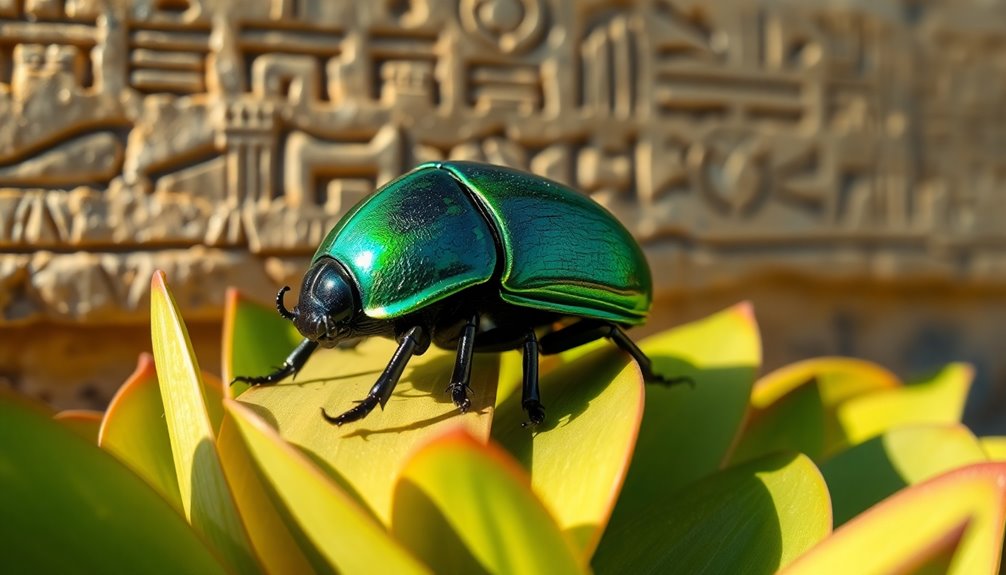
Amulets featuring scarabs played an important role in ancient Egyptian culture, embodying protection and the promise of rebirth. These Egyptian scarabs were more than just decorative pieces; they were crucial in funerary rituals and symbolized the cycle of life and death.
You'd find scarabs intricately carved and placed in tombs as heart scarabs, believed to aid the deceased on their journey in the afterlife.
Here are some key cultural practices involving scarabs:
- Scarabs were used as amulets to guard against evil.
- Heart scarabs helped weigh souls against the feather of Ma'at.
- The first scarab amulets emerged during the 6th Dynasty.
- Pharaohs produced commemorative scarabs to celebrate achievements.
- Scarabs emphasized the sun's daily cycle, reflecting life's renewal.
Through these practices, the scarab became a powerful symbol of resurrection and divine protection.
Artistic Representations in Egyptian Art

Scarabs dominate ancient Egyptian art, symbolizing the profound themes of death, rebirth, and the eternal cycle of life. You'll find scarabs prominently featured in tomb paintings, jewelry, and sculptures, reflecting their significance in funerary practices and beliefs about the afterlife.
These artistic representations often connect scarabs with powerful deities like Ra and Khepri, emphasizing their role in the cosmic order. The intricate details in scarab motifs, including wings and hieroglyphs, convey messages of power and protection.
In the context of burial traditions, these designs weren't merely decorative; they held deep spiritual meaning. You might notice that many scarabs served as amulets, believed to offer mystical protection against evil, showcasing their practical uses in daily life and afterlife beliefs.
Crafted from materials like faience and gemstones, scarabs highlight the exceptional skill of ancient Egyptian artisans. Their craftsmanship reflects a culture deeply invested in spiritual and cultural expression.
When you appreciate these artistic representations, it becomes clear that scarabs are more than just insects; they embody a rich tapestry of ancient Egyptian beliefs surrounding life, death, and rebirth.
Modern Interpretations and Symbolism

Today, the scarab beetle continues to captivate people as a symbol of transformation and rebirth. This ancient emblem has woven itself into modern culture, taking on new meanings while retaining its historical significance.
You might see scarabs in various forms, reflecting their lasting impact:
- Jewelry and Art: Scarabs are popular motifs, often seen as good luck charms. The symbolism of the scarab can be likened to the benefits of aromatherapy for emotional balance, which also promotes a sense of well-being and rejuvenation.
- Tattoos: Many choose scarab imagery to symbolize resilience and the cyclical nature of life and death.
- Empowerment: The scarab represents personal growth, encouraging individuals to embrace their journeys of regeneration. Additionally, their transformative power can be likened to the effects of herbal alternatives for botox-like effects, which promote skin rejuvenation and vitality. The scarab's enduring legacy is akin to the concept of spiritual alchemy symbols, which also signify profound transformation. Just as individuals can grow and transform through difficult experiences, those in narcissistic relationships often find strength in overcoming emotional challenges.
- Tourism: Egypt capitalizes on the scarab's cultural status, selling replicas and amulets that evoke ancient beliefs about protection.
- Media: Scarabs appear in literature and film, symbolizing hope and renewal, resonating with universal themes of transformation.
Additionally, the significance of the scarab can be compared to the concept of unconditional love, as both embody profound support and acceptance through life's changes.
Ecological Role of Scarab Beetles

When you look closely at ecosystems, you'll find that scarab beetles play an essential role in maintaining balance and health.
These remarkable insects are detritivores, feeding on decomposing plant and animal matter. By doing so, they aid in nutrient cycling and help decompose waste, which is vital for ecosystem health. Their dung burial behavior is particularly significant; it not only recycles nutrients back into the soil but also enhances soil aeration, promoting healthier plant growth.
Scarabs also contribute to seed burial and seedling recruitment, boosting biodiversity in forest ecosystems.
By managing the waste from livestock, scarab beetles save farmers millions, preventing waste accumulation in cattle farming. Their presence in an environment serves as a reliable indicator of ecological health and biodiversity.
When you see scarabs thriving, it's a good sign that the ecosystem is in balance, reflecting life amidst the inevitability of death.
Fascinating Facts About Scarabs

In the world of insects, few are as enchanting as scarabs, with their rich history and remarkable abilities. Revered in ancient Egypt, especially the dung beetle *Scarabaeus sacer*, these creatures symbolize both death and rebirth, closely tied to the sun god Ra.
Here are some fascinating facts about scarabs:
- Scarabs can roll dung balls weighing up to 1,141 times their body weight, showcasing incredible strength.
- They undergo complete metamorphosis: egg, larva, pupa, and adult, feeding on decomposing matter, which highlights their role in renewal. This process is akin to how nutrient recycling is vital for maintaining ecological balance. Engaging with scarabs in nature can enhance sensory experiences, much like how children explore their environment through play with Waldorf toys. This transformation reflects the principles of continuous learning, emphasizing the importance of adaptation in nature. The ability of scarabs to process waste contributes to ecosystem health, demonstrating their crucial role in environmental sustainability.
- Scarab amulets were popular in funerary practices, symbolizing protection and assisting souls in their afterlife journey.
- These insects use the Milky Way for navigation, demonstrating their unique behavioral adaptations.
- Scarabs play a vital role in nutrient recycling, maintaining ecological balance in their habitats.
- Their life cycle exemplifies the concept of personal growth and improvement, showcasing how transformation can lead to resilience and adaptability.
With their intricate life cycle and cultural significance, scarabs embody the essence of transformation.
Next time you see one, remember its connection to the sun god and the timeless cycle of life, death, and rebirth.
Frequently Asked Questions
What Insect Symbolizes Death and Rebirth?
When you think about insects that represent death and rebirth, you might be surprised to learn that the scarab beetle stands out.
This remarkable creature's behavior of rolling dung into balls symbolizes renewal and regeneration. In ancient cultures, especially Egypt, it was revered as a powerful emblem of the cycle of life.
As you explore its significance, you'll uncover themes of resurrection and immortality closely tied to this fascinating insect.
What Symbolizes Both Death and Rebirth?
When you think about symbols of both death and rebirth, look to the phoenix. This mythical bird rises from its ashes, embodying transformation and renewal.
You might also consider the lotus flower, which blooms beautifully above muddy waters, signifying purity and rebirth despite its murky beginnings.
These symbols remind you that endings often lead to new beginnings, illustrating the constant cycle of life that we all experience in various forms.
What Animal Symbolizes Death and Rebirth?
When you think about animals that symbolize death and rebirth, you might consider the phoenix. This mythical bird rises from its ashes, representing renewal and the cyclical nature of life.
You could also look at the owl, often seen as a wise guide between worlds, or the raven, which many cultures view as a transformative messenger.
Each of these creatures carries profound meanings related to life's changes, making them powerful symbols in your journey.
What Egyptian Insect Symbolizes Death and Rebirth?
Did you know that ancient Egyptians believed that scarab beetles could roll dung up to 50 times their weight? This fascinating fact highlights the importance of the dung beetle, or *Scarabaeus sacer*, in Egyptian culture.
You'll find that this insect symbolizes death and rebirth, deeply linked to the cycles of life. Scarabs were often used in art and jewelry, representing regeneration and the hope for resurrection in the afterlife.
Conclusion
In the dance of life and death, the scarab beetle takes center stage, rolling its precious ball of dung like a cosmic jewel. This humble insect, revered in ancient Egypt, embodies the cycle of transformation, reminding us that from decay springs new life. As you ponder the mysteries of the scarab, let it inspire you to embrace change, for in every ending lies the promise of a vibrant new beginning, waiting to unfold.

